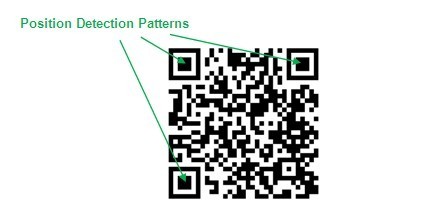The growing prevalence of LED displays offers advertisers dynamic opportunities for interactive campaigns. Led Qr codes, displayed on screens and billboards, have emerged as a powerful tool for engaging audiences. However, successfully integrating QR codes with LED technology requires overcoming specific technical hurdles to ensure seamless scanning. This article delves into the challenges and solutions for optimizing LED QR code scannability.
Common Challenges Affecting LED QR Code Scannability
Several factors can hinder the scannability of QR codes on LED displays:
1. Position Detection Pattern Failures
QR codes rely on three position detection patterns located in the corners (see Figure 1). These patterns enable omnidirectional, high-speed scanning. However, low refresh rates on some indoor LED displays can disrupt these patterns, making scanning difficult or impossible. When the refresh rate is insufficient, the camera struggles to capture a clear and stable image of the position detection patterns.
Figure 1: Position detection patterns of a QR code
2. QR Code Module Distortion
Two primary factors contribute to module distortion:
-
Limited Gray Scale Capabilities: LED displays with inadequate gray scale reproduction (e.g., less than 14-bit) can create color discrepancies within the QR code modules. These differences, perceived by smartphone cameras and scanners, lead to distortion. This distortion makes it difficult for the scanning software to accurately interpret the code.
-
Improper Image Scaling: Manual scaling or the use of a video processor incapable of accurate scaling can introduce distortions, as depicted in Figure 2. Such distortions negatively impact scanning speed and may result in complete scan failures. The modules may appear stretched or compressed, rendering the code unreadable.
Figure 2: Module distortion when scaling images manually
LED Driver ICs and QR Code Performance
LED display driver ICs significantly influence QR code scannability. Typical driver ICs often require trade-offs between high refresh rates, high gray scale, and high brightness. Prioritizing one often compromises the others.
Typical Driver IC Challenges
In brightly lit environments, LED displays often operate in high brightness mode. However, this mode typically reduces refresh rates and gray scale capabilities, leading to QR code scanning issues.
Figure 3: QR code scan result on an LED display at “high refresh rate” mode (The picture on the left corner is the original image.)
Operating in high gray scale mode, while improving image quality, can result in lower refresh rates. This can lead to the capture of black stripes by the camera, as shown in Figure 4, further hindering scanning.
Figure 4: QR code scan result on an LED display at “high gray scale” mode (The picture on the left corner is the original image.)
The Solution: S-PWM LED Driver ICs
S-PWM (Scanning Pulse Width Modulation) driver ICs offer a solution by simultaneously delivering high gray scale, high refresh rates, and high luminous efficacy. This eliminates the need for compromises, enabling optimal LED QR code display.
Figure 5: The QR code scan result on an LED display with Macroblock S-PWM LED driver ICs (The picture on the left corner is the original image.)
With S-PWM technology, QR codes are displayed clearly and consistently, ensuring quick and reliable scanning, as illustrated in Figure 5.
Conclusion
For effective LED QR code marketing campaigns, optimizing scannability is crucial. By understanding the technical challenges and leveraging advanced technologies like S-PWM driver ICs, advertisers can unlock the full potential of LED QR code engagement. High refresh rates and sufficient gray scale capabilities are essential for clear, scannable QR codes on LED displays. Choosing the right LED display technology ensures a positive user experience and successful campaign outcomes.
